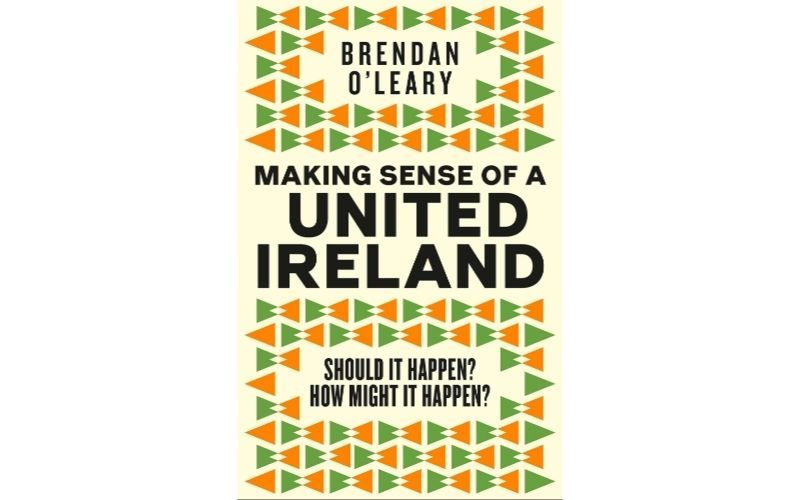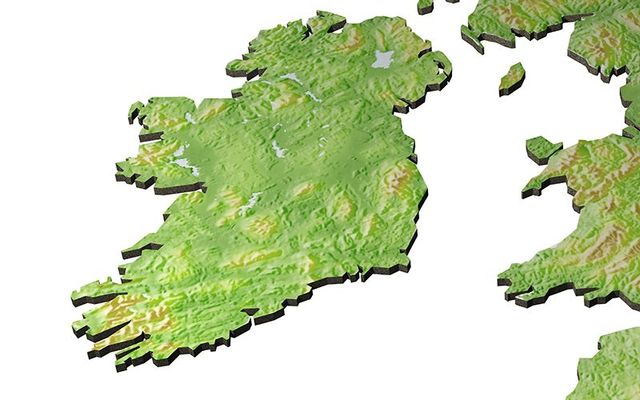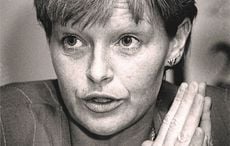"Making Sense of a United Ireland" by Professor Brendan O’Leary, Lauder Professor of Political Science at the University of Pennsylvania, is a tour de force, a highly readable, stylishly written, and essential book for anyone interested in a united Ireland, whether supportive, opposed or simply anxious about disturbing the peace we have enjoyed for 25 years. Irish Americans will particularly appreciate this as a handbook to be used as the Irish unity debate heats up over the next ten years.
As most readers know, Irish nationalists have fought for centuries for an independent united Ireland, free of its larger and imperialist neighbor. In 1921, that goal was partly achieved by the creation of the Irish Free State, but six counties in the North that could guarantee a sizable majority of those unionists loyal to Britain were retained as Northern Ireland under Protestant unionist rule and part of the UK.
Making Sense of Irish Unity explains how those unionists have now lost that majority in the North, and that we are on the verge of a truly historic event whereby “it is plausible that a referendum in the North might be called around 2030.” Moreover, the author continues, “it is probable that it can be won by non-unionists…because Northern Ireland’s tectonic plates have shifted.” This change is possible because what O’Leary calls the “cultural Catholic population” – those who are Catholic or come from a predominantly Catholic family formation – now out-number “cultural Protestants."

"Making Sense of a United Ireland" by Professor Brendan O’Leary.
This striking demographic development was confirmed in the 2019 UK elections, where in Northern Ireland, nationalists won nine of the eighteen seats, while the middle ground Alliance party took North Down, creating the first-ever non-unionist majority delegation from Northern Ireland in the London parliament. (Incidentally, many would argue that now is a good time for Sinn Fein to take its seats in London to demonstrate that change.)
Why all this matters is that the Good Friday Agreement requires the British Secretary of State for Northern Ireland to call a referendum in Northern Ireland, “if at any time it appears likely to him that a majority of those voting would express a wish that Northern Ireland should cease to be part of the United Kingdom and form part of a united Ireland.” The South would also have to pass such a referendum which requires careful preparation despite the historic aspiration for a united Ireland. (O’Leary prefers the term reunification as historically accurate but uses unification also.)
O’Leary argues therefore that we had better start preparing for Irish unity now, rather than hoping it will be all right on the day: “The need to prepare for the possibility of reunification affects all on this island, and it affects our diasporas.” Brexit has also accelerated the impetus to Irish unity because it undermined the common identity that nationalists and unionists in the North enjoyed inside the European Union. In addition, an increasingly xenophobic British government appears to have abandoned parity of esteem in the North, a central pillar of the Good Friday Agreement.
O’Leary is no cheery-eyed optimist, warning that the preparation will have to include credible changes and guarantees “to make unionists feel welcome and secure in their own homeland, homes, and places of work and leisure.” His rationale is, “if a united Ireland happens it will be helped to referendum victory by Sinn Féin voters, but they will not be pivotal. In the South, the decisive votes will be cast by those who currently support Fianna Fáil or Fine Gael, or other political parties, currently nearly two-thirds of the electorate. In the North, the decisive votes will be cast by SDLP and Alliance voters, and the neither/nors, those who ‘don’t know’ right now, and by people who have ceased to be unionists.”
However, persuading unionists to accept any form of Irish unity will not be easy, given their history of violent resistance to reforms in Northern Ireland, including the loyalist attacks on civil rights marchers in the 1960s and 1970s and the current refusal of the DUP to share power in the North. Achieving German reunification in 1990 was much easier by comparison, the Soviet Union which controlled East Germany was collapsing and most East Germans were in agreement with West Germans on German identity.
In a chilling reference to the potential security implications of Irish unity for the whole island, O’Leary is critical of the Republic’s under-investment in security, dropping from 1 percent of GDP in 1997 to 0.3 percent in 2020. Not only, the author argues, does this mean that Ireland will not be a meaningful player in protecting the EU from invasion, but it also suggests a less robust ability to confront violence from either loyalist or republican extremists at home. Indeed, one of the major threats to a Yes vote in a referendum on Irish unity in the South would be a fear of having to use the army and police to maintain order in the North.
There is also a possibility that a British government would attempt to defeat a vote for Irish unity, although former Irish Ambassador to the US, Sean O hUiginn, states that a clause in the Good Friday Agreement barring “external impediment” was ‘a polite way of saying there should be no British finger pressing the scale against unity, that is, a reinforcement of the British neutrality pledge.’
O’Leary is widely experienced in conflict resolution and grew up amid three civil wars in Nigeria, Sudan and Northern Ireland. He deploys the four principles of “consociational thought” in deeply divided societies: parity, proportionality, autonomy, and veto rights, and notes that all four are incorporated in the Good Friday Agreement. The book is the most comprehensive study yet of the myriad of constitutional, governmental, security, economic, educational, healthcare, and identity challenges that need to be addressed to abide by these principles and to ensure a peaceful and successful transition.

Love Irish history? Share your favorite stories with other history buffs in the IrishCentral History Facebook group.
Professor O’Leary doesn’t advocate one specific united Ireland model but honestly details the pros and cons of each model. Indeed, one key issue to resolve is whether the referendum offers a specific model of Irish unity or a credible and inclusive process to achieve that unity. Given the uncertainty around the future, it’s likely that many people north and south would not want to buy “a pig in a poke.” Instead, it seems that a specific model should be proposed that would command a majority North and South.
The simplest model would be to simply switch the sovereignty over Northern Ireland from London to Dublin, retaining the North as a separate body with autonomy over local government, and with a Bill of Rights and other guarantees for British and Irish identity and culture. This might be the least disruptive model; for British unionists, it may seem less like they are been swallowed up by the Republic. For people living in the South, it will seem that unity does not mean losing the stability of the existing state.
British unionists have always feared being subsumed by a priest-ridded, backward Republic, but O’Leary shows how the South is a “more modernized, liberalized, secularized, law-abiding, tolerant, and pluralist country than that governed by the British Parliament… Its Constitution constrains majority rule, and its proportional representation system ensures that governments are formed with genuine majorities. Northern Ireland will benefit politically from integrating with the Republic. It will improve its democratic life, and all its citizens will have more influence in an all-island polity than they do within the UK; and if counsel given here is heard, some of the best Northern practices will follow them.”
O’Leary attacks the “tyranny of the majority” which has bedeviled the North for so long and which should not be replicated in a united Ireland. In a key passage that should be pinned on every Irish wall, O’Leary states unequivocally, “It is right to accommodate minority identifications – symbolically and substantively – as well as dual citizenship rights. It is appropriate to consider power-sharing carefully given past antagonisms – preserving the arrangements in the North, perhaps, or instead considering new ones in an integrated Ireland. It is prudent to avoid provoking a loyalist insurrection, and equally prudent to be prepared to defeat one.”
The author also proposes that the future government of a united Ireland adopt the d’Hondt rule of proportionality that is currently used to fill committee places in the European Parliament and to fill places in the Northern Executive. While this would test cabinet cohesion in Dublin, it would ensure that British unionists would always have a role in governing a united Ireland.
The book details what other rights, protections, and securities British people in Ireland and cultural Protestants may want – and should have – in a reunified Ireland. What deliberative process would result in the best elucidation of these protections in preparation for two referendums? In 1983/84, the New Ireland Forum, which was boycotted by unionists, succeeded through a process of a year’s intensive public and private debates in creating a new nationalist consensus that recognized the equal rights and identity of nationalists and unionists in a new Ireland. Now, some similar exercise is required by nationalists to examine and debate how to retain the best of the North and South in a united Ireland, free of the old shibboleths.
As for the argument that the South cannot or will not afford the cost of unity, the book makes the valid case that the South with its current growth rate will in ten years be able to afford the approximately $10 billion annual subvention from Britain to the North. The economist David McWilliams is quoted that “the Republic’s industrial output is today 10 times that of the North. Exports from the Republic are 17 times greater than those from Northern Ireland, and average income per head in the Republic, at €39,873, dwarfs the €23,700 across the border.”
And if the Protocol survives for the North, its own economy will benefit from tariff-free access to the EU and British markets. O’Leary believes that a united Ireland will benefit from a larger national market, more closely integrated into the European single market and attractive to US foreign investment – all as part of the most dynamic and largely English-speaking economic unit in the western EU. “The North will benefit most, but the South would make net gains too if the economic modeling described here is broadly correct. A united Ireland may also be judged a comparatively better democracy than its immediate neighbor.”
Irish Americans would also welcome a united Ireland that continues to be open to America and the European Union, not arbitrarily choosing between “Boston and Berlin.” The book shows that “the EU is Ireland’s largest market (37 percent of its exports by value in 2021). The US is next (32 percent).
O’Leary accurately stresses that “to become prosperous, Ireland learned many things, including to educate as many as possible – scientifically, not clerically. The most important lesson is that western Atlantic isolation is a recipe for stagnation and the export of Irish citizens. Having arrived in the UN, and then the EEC and its EU successor, no reversion to isolation makes
sense. Ireland must remain attractive to outsiders, and sufficiently attractive to our diaspora that it will continue to want to return.”
And this advice from O’Leary might be as equally relevant in today’s turbulent America as in Ireland: “People’s identities, to the extent that they matter, should be as freely chosen as possible.”
The closing lines of this fascinating and ultimately optimistic book are hopefully ones that everyone can embrace at home and abroad, “Reunification should offer a positive fresh start for all, a reset on our island, an opportunity for joint renewal of our institutions, our relationships, our policies, our international alliances, our economic, cultural, and social policies, our freedoms, and our rights.”
* Ted Smyth, a former Irish diplomat, is President of the Advisory Board of Glucksman Ireland House, the Center of Irish and Irish American Studies at New York University.




Comments